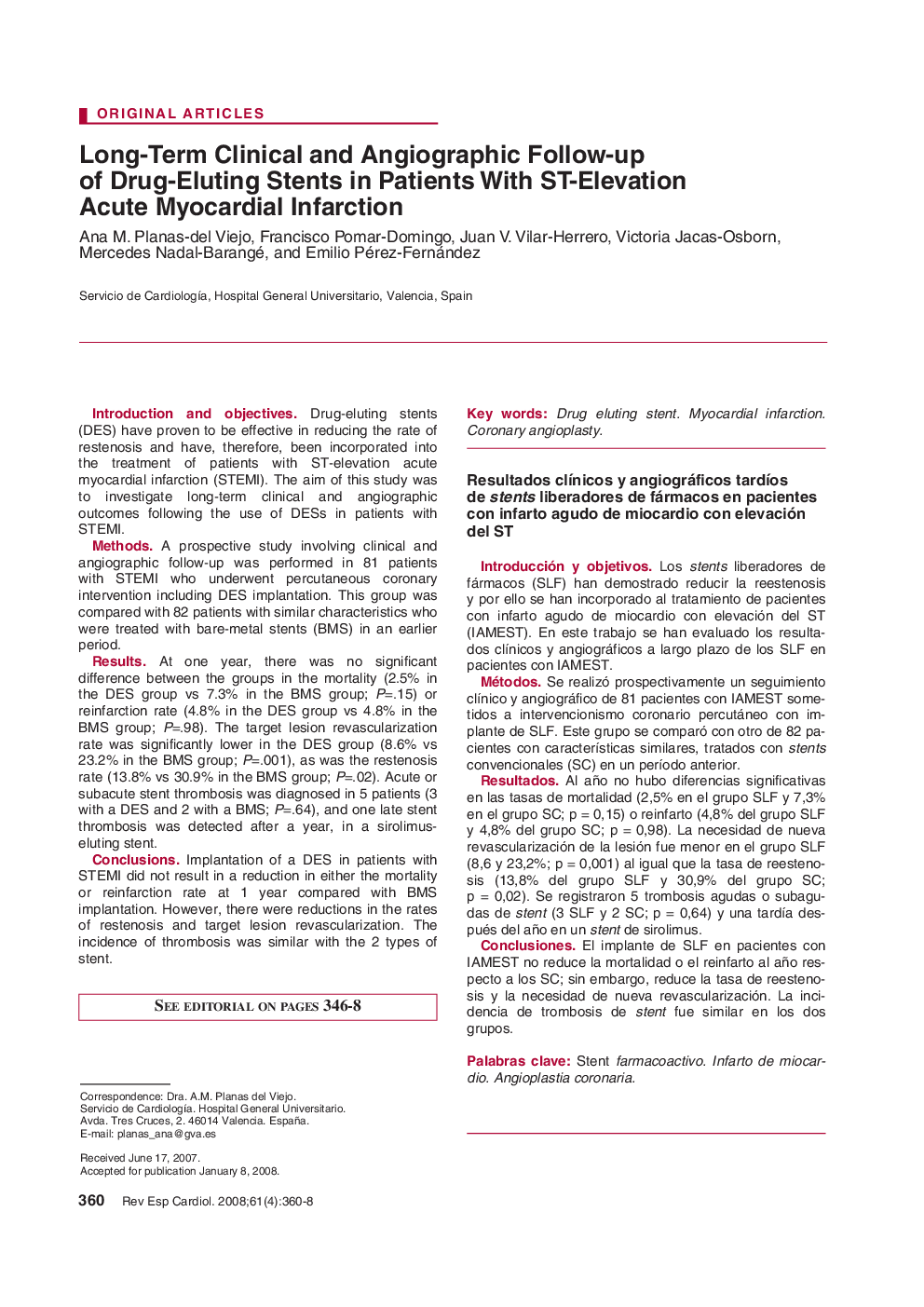| Article ID | Journal | Published Year | Pages | File Type |
|---|---|---|---|---|
| 3018858 | Revista Española de Cardiología (English Edition) | 2008 | 9 Pages |
Introduction and objectivesDrug-eluting stents (DES) have proven to be effective in reducing the rate of restenosis and have, therefore, been incorporated into the treatment of patients with ST-elevation acute myocardial infarction (STEMI). The aim of this study was to investigate long-term clinical and angiographic outcomes following the use of DESs in patients with STEMI.MethodsA prospective study involving clinical and angiographic follow-up was performed in 81 patients with STEMI who underwent percutáneous coronary intervention including DES implantation. This group was compared with 82 patients with similar characteristics who were treated with bare-metal stents (BMS) in an earlier period.ResultsAt one year, there was no significant difference between the groups in the mortality (2.5% in the DES group vs 7.3% in the BMS group; P=.15) or reinfarction rate (4.8% in the DES group vs 4.8% in the BMS group; P=.98). The target lesión revascularization rate was significantly lower in the DES group (8.6% vs 23.2% in the BMS group; P=.001), as was the restenosis rate (13.8% vs 30.9% in the BMS group; P=.02). Acute or subacute stent thrombosis was diagnosed in 5 patients (3 with a DES and 2 with a BMS; P=.64), and one late stent thrombosis was detected after a year, in a sirolimuseluting stent.ConclusionsImplantation of a DES in patients with STEMI did not result in a reduction in either the mortality or reinfarction rate at 1 year compared with BMS implantation. However, there were reductions in the rates of restenosis and target lesión revascularization. The incidence of thrombosis was similar with the 2 types of stent.
Introducción y objetivosLos stents liberadores de fármacos (SLF) han demostrado reducir la reestenosis y por ello se han incorporado al tratamiento de pacientes con infarto agudo de miocardio con elevación del ST (IAMEST). En este trabajo se han evaluado los resultados clínicos y angiográficos a largo plazo de los SLF en pacientes con IAMEST.MétodosSe realizó prospectivamente un seguimiento clínico y angiográfico de 81 pacientes con IAMEST some-tidos a intervencionismo coronario percutáneo con implante de SLF. Este grupo se comparó con otro de 82 pacientes con características similares, tratados con stents convencionales (SC) en un período anterior.ResultadosAl año no hubo diferencias significativas en las tasas de mortalidad (2,5% en el grupo SLF y 7,3% en el grupo SC; p = 0,15) o reinfarto (4,8% del grupo SLF y 4,8% del grupo SC; p = 0,98). La necesidad de nueva revascularización de la lesión fue menor en el grupo SLF (8,6 y 23,2%; p = 0,001) al igual que la tasa de reestenosis (13,8% del grupo SLF y 30,9% del grupo SC; p = 0,02). Se registraron 5 trombosis agudas o subagudas de stent (3 SLF y 2 SC; p = 0,64) y una tardía después del año en un stent de sirolimus.ConclusionesEl implante de SLF en pacientes con AMEST no reduce la mortalidad o el reinfarto al año respecto a los SC; sin embargo, reduce la tasa de reestenosis y la necesidad de nueva revascularización. La incidencia de trombosis de stent fue similar en los dos grupos.
